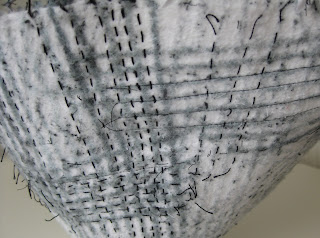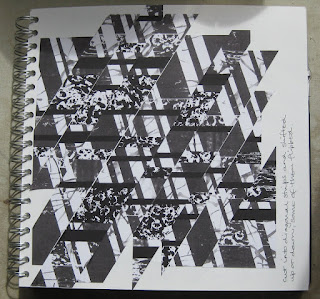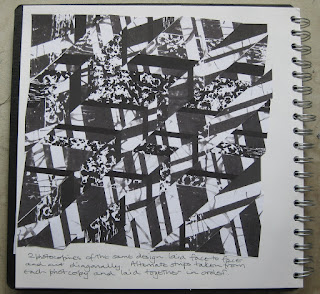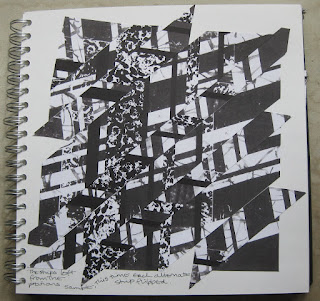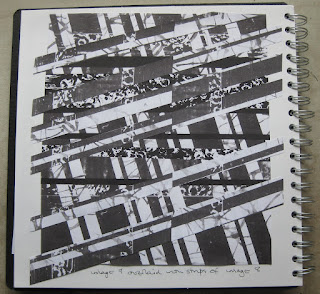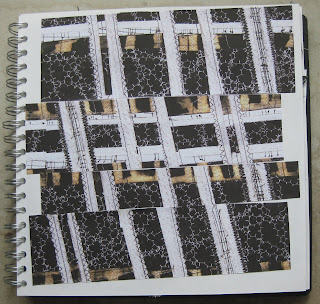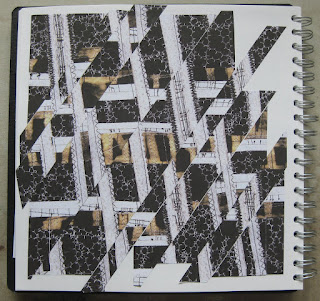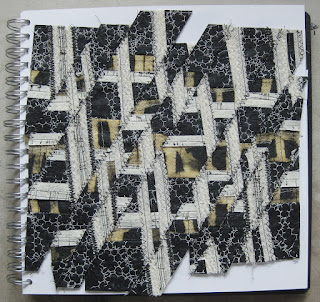Timings
Introduction 5.5 hours
Chapter 1 7 hours
Chapter 2 33.5 hours
Chapter 3 14.5 hours
Chapter 4 15 hours
Chapter 5 9.5 hours
Chapter 6 23.5 hours
Chapter 7 21.25 hours
Chapter 8 14.75 hours
Chapter 9 12.5 hours
Chapter 10 16 hours
Chapter 11 39 hours
Chapter 12 41.5 hours
Chapter 13 6 hours
TOTAL 254 hours
Costings
3 sketchbooks £27
paper £5
art materials £5
dyes £9.85
fabric £16.29
lutrador £2.50
pelmet vilene £5.90
thread £12
TOTAL £73.64
Details of the embroidered assessment piece
Design work started: 22/04/2012
Time spent on design stage: 29.5 hours
Final item started: 26/09/2012
Final item finished : 9/10/2012
Time spent making final item: 12 hours
Materials used
half a metre of pelmet vilene £2.95
fabric £5
dye and paint £2.50
thread £1
lead weight for base 20p
TOTAL £11.65
EVALUATION OF FUNCTIONAL 3D EMBROIDERED ITEM
The completed embroidered assessment piece for Module 2 is a vessel based on the design topic of animal markings.
How do you feel about the resulting conclusion?
My aim was to make a sculptural vessel which could be used as a container for say pot pouri, although I would display it simply as a sculptural piece.
I was keen to find a way of making it out of one layer of fabric and chose pelmet vilene. I discovered that by attaching threads and strips of fabric to one side of the vilene using an embellisher, I created a shadow of the "front" on the "back" which I really liked. The embellisher also softened the vilene and made it more pliable, but care needs to be taken not to weaken the vilene.
It was an easy decision to put the textured side inside the vessel rather than on the outside, because looking at the vessel, because of its shape, you tend to see more of the inside.
Generally I am extremely pleased with the outcome. I particularly like the translucency when there is light behind it, which I had not expected.
Is it fit for its purpose - give reasons?
I think it is a very beautiful shape and therefore very visual. Thanks to the lead curtain weight sewn between the two layers of the base it is very stable, and would therefore act as a container.
If you were asked to make it again, what changes would you make to the way you designed it and the way you made it?
There are three aspects I would look at if I were to make it again.
I would look at the curve of the top which is very important to the overall look of the piece, to see whether it could be further refined. In particular I would see whether the short edge at the join could be shorter, making a more dramatic line.
I would also look at the treatment of the edge, to see if I could find a way of making it more ethereal. I like the way the strips of fabric extend beyond the edge, but I don't like the solidity of the cut edge of the vilene.
I would also see if there is a different fabric I could use as the base fabric. It would need to be self supporting after it had been embellished, so it may be that the vilene is the best choice.
Health & Safety
Sewing machine, embellisher
- Keep machines clean and well oiled
- Have a comfortable chair that is the correct height for comfortable working relative to the table the machine is on
- Make sure that the leads are out of the way and not snaking around to be tripped on
- Take regular breaks
- Make sure that the light is good
Rotary cutter, Stanley knife, scalpel
- Always use with a cutting mat and a safety ruler
- Always make sure that the blade is retracted / locked when not in use
- Never cut towards yourself but always away from yourself.
- Keep you hands clear of the cutting edge
Dyeing
- Always wear protective clothing and rubber gloves
- Always wear a mask when working with powders and mixing dyes
- Ensure that the utensils are dedicated to dyeing and not used for food preparation
- Protect work surfaces from spillages
- Ensure that unused dyes etc are kept in clearly marked containers and in a safe place out of the reach of children
- If working indoors, make sure that the room is well ventilated
General working
- Have a comfortable chair that is the correct height for comfortable working reyelative to the table
- Take regular breaks
- Make sure that the light is good
- Keep your working area tidy and keep electric leads out of the way















